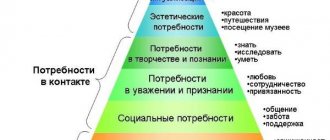Personal needs (need) are the so-called source of personal activity, because it is a person’s needs that are his motivation for acting in a certain way, forcing him to move in the right direction. Thus, need or need is a personal state in which the dependence of subjects on certain situations or conditions of existence is revealed.
Personal activity manifests itself only in the process of satisfying its needs, which are formed during the upbringing of the individual and his introduction to public culture. In its primary biological manifestation, need is nothing more than a certain state of the organism, expressing its objective need (desire) for something. Thus, the system of individual needs directly depends on the individual’s lifestyle, the interaction between the environment and the sphere of its use. From the perspective of neurophysiology, need means the formation of some kind of dominant, i.e. the appearance of excitation of special brain cells, characterized by stability and regulating required behavioral actions.
Types of personality needs
Human needs are quite diverse and today there are a huge variety of their classifications. However, in modern psychology there are two main classifications of types of needs. In the first classification, needs (needs) are divided into material (biological), spiritual (ideal) and social.
The realization of material or biological needs is associated with the individual-species existence of the individual. These include the need for food, sleep, clothing, safety, home, intimate desires. Those. need (need), which is determined by biological need.
Spiritual or ideal needs are expressed in knowledge of the world around us, the meaning of existence, self-realization and self-esteem.
The desire of an individual to belong to any social group, as well as the need for human recognition, leadership, dominance, self-affirmation, affection of others in love and respect is reflected in social needs. All these needs are divided into important types of activity:
- labor, work - the need for knowledge, creation and creation;
- development – the need for training, self-realization;
- social communication – spiritual and moral needs.
The needs or needs described above have a social orientation, and therefore are called sociogenic or social.
In another type of classification, all needs are divided into two types: need or need for growth (development) and conservation.
The need for conservation combines the following physiological needs (needs): sleep, intimate desires, hunger, etc. These are the basic needs of the individual. Without their satisfaction, the individual is simply unable to survive. Next is the need for security and preservation; abundance – comprehensive satisfaction of natural needs; material needs and biological.
The need for growth combines the following: the desire for love and respect; self-actualization; self-esteem; knowledge, including life meaning; needs for sensory (emotional) contact; social and spiritual (ideal) needs. The above classifications make it possible to highlight the more significant needs of the subject’s practical behavior.
OH. Maslow put forward the concept of a systematic approach to research into the psychology of personality subjects, based on a model of personality needs in the form of a pyramid. Hierarchy of personality needs according to A.Kh. Maslow represents the behavior of an individual that directly depends on the satisfaction of his any needs. This means that the needs at the top of the hierarchy (realization of goals, self-development) direct the individual’s behavior to the extent that his needs at the very bottom of the pyramid (thirst, hunger, intimate desires, etc.) are satisfied.
They also distinguish between potential (non-actualized) needs and actualized ones. The main driver of personal activity is the internal conflict (contradiction) between the internal conditions of existence and external ones.
All types of personal needs located at the upper levels of the hierarchy have different levels of expression in different people, but without society, not a single person can exist. A subject can become a full-fledged personality only when he satisfies his need for self-actualization.
Classification of motives
All motives can be divided into the following groups, in accordance with their nature of occurrence: • social: the need for safety, security, recognition, public approval, etc.; • hierarchical in degree of significance (leading and subordinate motives) and time of their occurrence; • by source of occurrence: internal or external; • in relation to consciousness: conscious and unconscious.
Motives, together with needs and goals, are the main components of a person’s motivational sphere. Thanks to it, we develop, act, commit certain actions, achieve the goals set for us, improve ourselves and assert ourselves in society, and achieve self-realization in life.
In modern society, to achieve success it is important to have a broad and flexible motivational sphere. To do this, you need to develop its main components every day, learn to manage emotions, analyze your desires and be able to compare them with intentions, and also constantly expand your horizons.
Social needs of the individual
This is a special kind of human need. It lies in the need to have everything necessary for the existence and functioning of an individual, a social group, or society as a whole. This is an internal motivating factor for activity.
Social needs are the need of people for work, social activity, culture, and spiritual life. The needs created by society are those needs that are the basis of social life. Without motivating factors to satisfy needs, production and progress in general are impossible.
Social needs also include those associated with the desire to form a family, joining various social groups, teams, various areas of production (non-production) activity, and the existence of society as a whole. Conditions and environmental factors that surround an individual in the process of his life not only contribute to the emergence of needs, but also create opportunities to satisfy them. In human life and the hierarchy of needs, social needs play one of the determining roles. The existence of an individual in society and through it is the central area of manifestation of the essence of man, the main condition for the realization of all other needs - biological and spiritual.
Social needs are classified according to three criteria: the needs of others, their own needs, and common needs.
The needs of others (needs for others) are needs that express the generic basis of the individual. It lies in the need for communication, protection of the weak. Altruism is one of the expressed needs for others, the need to sacrifice one's interests for others. Altruism is realized only through victory over egoism. That is, the need “for oneself” must be transformed into a need “for others.”
One’s own need (need for oneself) is expressed in self-affirmation in society, self-realization, self-identification, the need to take one’s place in society and the team, the desire for power, etc. Such needs are therefore social, because they cannot exist without needs “for others.” " Only through doing something for others is it possible to realize your desires. Take some position in society, i.e. It is much easier to achieve recognition for oneself without affecting the interests and claims of other members of society. The most effective way to realize your egoistic desires will be a path along which a share of compensation is contained to satisfy the claims of other people, those who can claim the same role or the same place, but can be satisfied with less.
Joint needs (needs “together with others”) - express the motivating power of many people at the same time or society as a whole. For example, the need for security, freedom, peace, a change in the existing political system, etc.
Needs and motives of the individual
The main condition for the life of organisms is the presence of their activity. In animals, activity manifests itself in instincts. But human behavior is much more complex and is determined by the presence of two factors: regulatory and incentive, i.e. motives and needs.
The motives and system of needs of the individual have their own main characteristics. If need is need (scarcity), the need for something and the need to eliminate something that is in abundance, then the motive is a pusher. Those. need creates a state of activity, and motive gives it direction, pushes activity in the required direction. Necessity or necessity, first of all, is felt by a person as a state of tension inside, or manifests itself as thoughts, dreams. This encourages the individual to search for an item of need, but does not give direction to the activity to satisfy it.
Motive, in turn, is an incentive to achieve the desired or, conversely, to avoid it, to carry out an activity or not. Motives can be accompanied by positive or negative emotions. Satisfying needs always leads to a release of tension; the need disappears, but after a while it can arise again. With motives, the opposite is true. The stated goal and the immediate motive do not coincide. Because a goal is where or what a person strives for, and a motive is the reason why he strives.
You can set a goal for yourself following different motives. But an option is also possible in which the motive shifts to the goal. This means transforming the motive of activity directly into a motive. For example, a student initially learns his homework because his parents force him to, but then interest awakens and he begins to study for the sake of learning itself. Those. It turns out that a motive is an internal psychological motivator of behavior or actions, which is stable and encourages an individual to carry out activities, giving it meaning. And need is an internal state of feeling need, which expresses the dependence of a person or animals on certain conditions of existence.
Functions of motives
The classification of functions performed by motives is presented in the works of A. N. Leontyev, A. B. Orlov and some other researchers. Summarizing various points of view, we can highlight the following functions of motives:
- activity activation function, or stimulating function. It comes down to the fact that motives generate the activity of the individual and stimulate it;
- Directional function. Motives correct the direction of a person’s activity and set a certain “vector” of activity;
- incentive function. Motives, stimulating activity, act as its root cause, and the activity itself becomes only a consequence of the influence of the motive. The drive function is characterized by the strength, tension, and intensity of a person’s aspirations for a certain type of activity; these aspirations may vary from person to person;
- meaning-forming function. It is connected with the fact that a motive is capable of giving a person’s activity a personal meaning, understood as the relationship between the motive and the purpose of the activity (A. N. Leontyev). Often the activities of different people are subordinated to the same socially significant goal (for example, the goal of a student’s activity is to obtain an appropriate education). However, the achievement of this goal can be determined by different personal meanings, which vary depending on what motive drives the person. For example, a student may study in order to obtain a diploma, acquire knowledge in a specific field of activity, or meet the expectations of a significant environment;
- integrative function. According to V. A. Ganzen, the human psyche is capable of performing not only a reflection function, but also an integrative function. This statement can be fully applied to the motives of the individual. Since man is a social being, the motives of his activity are associated with the inclusion of certain results of the “work” done in the surrounding social environment. At the same time, the natural needs of a person are not capable of integrating the individual and society (according to D. Leontyev, “a person is always alone in his needs”). And values and motives, on the contrary, play the role of an integrating factor in the process of interaction between people (this can be attributed to moral, religious, aesthetic and other values);
- regulatory function of motives. This function generalizes all the previous ones and boils down to the following: a motive subordinates a person’s behavior to the purpose for which it is carried out.
The listed functions can be reflected in various motives and to varying degrees. In addition, many motives are situational, that is, they appear only in a specific situation. However, according to the Novosibirsk psychologist V. G. Leontyev, throughout the entire process of motivating activity, all the main functions of motives are consistently manifested. Also, this researcher proposes to take into account another function of motives that has not previously been considered by other scientists - goal modeling.
Needs and interests of the individual
The category of need is inextricably linked with the category of interests. The origin of interests is always based on needs. Interest is an expression of an individual’s purposeful attitude towards some type of his needs.
A person’s interest is not so much directed specifically at the subject of need, but rather directed at such social factors that make this subject more accessible, mainly the various benefits of civilization (material or spiritual), which ensure the satisfaction of such needs. Interests are also determined by the specific position of people in society, the position of social groups and are the most powerful incentives for any activity.
Interests can also be classified depending on the focus or the carrier of these interests. The first group includes social, spiritual and political interests. The second includes the interests of society as a whole, group and individual interests.
The interests of an individual express his orientation, which largely determines his path and the nature of any activity.
In its general manifestation, interest can be called the true reason for social and personal actions, events, which stands directly behind the motives of individuals taking part in these very actions. Interest can be objective and objective social, conscious, realizable.
The objectively effective and optimal way to satisfy needs is called objective interest. Such interest is of an objective nature and does not depend on the consciousness of the individual.
An objectively effective and optimal way to satisfy needs in public space is called objective social interest. For example, there are a lot of stalls and shops in the market and there is definitely an optimal path to the best and cheapest product. This will be a manifestation of objective social interest. There are many ways to make various purchases, but among them there will definitely be one that is objectively optimal for a particular situation.
The subject's ideas about how best to satisfy his needs are called conscious interest. Such interest may coincide with the objective one or be slightly different, or may have a completely opposite direction. The immediate cause of almost all actions of subjects is precisely the interest of a conscious nature. Such interest is based on a person’s personal experience. The path that a person takes to satisfy the needs of the individual is called realized interest. It can completely coincide with the interest of a conscious nature, or absolutely contradict it.
There is another type of interest - this is a product. This variety represents both the path to satisfying needs and the way to satisfy them. A product may be the optimal way to satisfy a need and may appear to be so.
What have we learned?
Activity is human activity aimed at transforming reality to satisfy needs. Its structure is studied in 8th grade. Actions are based on motives - desires, motivations, needs, beliefs, attitudes.
Previous
Social studies Moral choice and moral responsibility - what is it, a brief definition for preparing a message (grade 8)
Next
Social studies The spiritual sphere of society: what is it, what does culture include, areas, structure and branches in brief on social science
Spiritual needs of the individual
The spiritual needs of the individual are a directed aspiration for self-realization, expressed through creativity or through other activities.
There are 3 aspects of the term spiritual needs of the individual:
- The first aspect includes the desire to master the results of spiritual productivity. This includes exposure to art, culture, and science.
- The second aspect lies in the forms of expression of needs in the material order and social relations in current society.
- The third aspect is the harmonious development of the individual.
Any spiritual needs are represented by a person’s internal motivations for his spiritual manifestation, creativity, creation, creation of spiritual values and their consumption, for spiritual communications (communication). They are determined by the individual’s inner world, the desire to withdraw into oneself, to focus on what is not related to social and physiological needs. These needs encourage people to engage in art, religion, and culture not in order to satisfy their physiological and social needs, but in order to understand the meaning of existence. Their distinguishing feature is their insaturability. Since the more internal needs are satisfied, the more intense and stable they become.
There are no limits to the progressive growth of spiritual needs. The limitation of such growth and development can only be the amount of spiritual wealth previously accumulated by humanity, the strength of the individual’s desires to participate in their work and his capabilities. The main features that distinguish spiritual needs from material ones:
- needs of a spiritual nature arise in the consciousness of the individual;
- needs of a spiritual nature are inherently necessary, and the level of freedom in choosing ways and means to satisfy such needs is much higher than that of material ones;
- satisfaction of most spiritual needs is mainly related to the amount of free time;
- in such needs, the connection between the object of need and the subject is characterized by a certain degree of unselfishness;
- the process of satisfying spiritual needs has no boundaries.
In terms of their content, spiritual needs are objective. They are determined by the totality of the living conditions of individuals and demonstrate the objective need for their spiritual study of the social and natural world that surrounds them.
Yu. Sharov identified a detailed classification of spiritual needs: the need for work; the need for communication; aesthetic and moral needs; scientific and educational needs; need for health improvement; the need of military duty. One of the most important spiritual needs of a person is knowledge. The future of any society depends on the spiritual foundation that will be developed among modern youth.
Psychological needs of the individual
The psychological needs of an individual are those needs that are not limited to bodily needs, but also do not reach the level of spiritual ones. Such needs usually include the need for affiliation, communication, etc.
The need for communication in children is not an innate need. It is formed through the activity of surrounding adults. Usually it begins to actively manifest itself by two months of life. Adolescents are convinced that their need for communication brings them the opportunity to actively use adults. For adults, insufficient satisfaction of the need for communication has a detrimental effect. They become immersed in negative emotions. The need for acceptance is the desire of an individual to be accepted by another person, a group of people or society as a whole. Such a need often pushes a person to violate generally accepted norms and can lead to antisocial behavior.
Among the psychological needs, basic needs of the individual are distinguished. These are needs that, if not met, young children will not be able to fully develop. They seem to stop in their development and become more susceptible to certain diseases than their peers who have such needs met. For example, if a baby is regularly fed but grows without proper communication with his parents, his development may be delayed.
The basic personal needs of adults of a psychological nature are divided into 4 groups: autonomy - the need for independence, independence; need for competence; the need for interpersonal relationships that are significant for the individual; the need to be a member of a social group and to feel loved. This also includes a sense of self-worth and the need to be recognized by others. In cases of unsatisfaction of basic physiological needs, the physical health of the individual suffers, and in cases of unsatisfaction of basic psychological needs, the spirit (psychological health) suffers.
LiveInternetLiveInternet
We enter into communication with other people thanks to the needs that are satisfied in this way. In communication, skills and abilities, called communication techniques, are also developed. The level of its development largely determines the effectiveness of interpersonal interaction. Practicing communication techniques, in addition to exercises, requires knowledge of the structure of communication. In the process of communication, a person does not think about how it works.
It’s another matter when he sets the task of improving his ability to communicate and eliminating internal obstacles. In this case, it is necessary to make communication the object of your attention and knowledge. Improving communication is necessary precisely because most conflicts arise in communication with loved ones, colleagues, and strangers with whom we are forced to come into contact. Since most fundamental human needs are satisfied in the behavior of other people (see posts about Human Needs), it is quite natural for questions to arise:
What needs are satisfied in communication?
What is the driving force behind communication?
Why do people come into contact with each other?
If you answer these questions specifically in each individual case (What does this person want from me? What kind of satisfaction do I get? Why do I maintain this communication?), then the internal forces of communication will be understood and errors leading to conflicts and tensions will be eliminated.
Therefore, the most important task of self-education is to increase the ability to understand the internal springs of communication.
Suppose you are asked: “What time is it?” or: “Have you heard the weather forecast for tomorrow?” The meaning contained in this single act of communication may be different. Maybe the student is interested in the weather in connection with tomorrow's cultural trip? Or does he just want to talk to you because he suffers from boredom and loneliness? Maybe he has exam anxiety? Perhaps he wants to turn the conversation to a discussion of his speech yesterday at the seminar and hear your judgment? It is unknown which of these assumptions is correct.
The success of the communication will depend on testing your assumptions and whether you accept his motivation for communicating. To judge motives, you need to know what needs support communication. In any case, your assumptions about the motives for communication will be more correct if you have sufficiently reliable information about the prevailing needs and motives for communication of the other person.
We focus on needs rather than on motives, since the latter are extremely diverse and closely related to situations, and therefore difficult to describe, unless they can be classified, and this is not enough. Even the medieval philosopher Ockham said: “Do not multiply entities unnecessarily.” Therefore, if we focus on motives, then they, as entities that explain behavior, will be too numerous to be easily manipulated for understanding. The number of fundamental needs is limited, there are several of them, and if you know them, you can achieve understanding.
We can talk about achieving, or dominant, behavior or about behavior oriented toward prestige, security, or self-affirmation through power over another. In this case, we use the concepts of prestige, security, and dominance needs, well developed by psychological science, as an explanatory entity. In this case, we better understand the simple fact that communication can be caused by a variety of needs. Communication can increase our prestige or desire for self-affirmation, dominance over others;
in communication we are saved from the oppressive feeling of loneliness, communication reduces tension and fear of the unknown;
by making contact, we discover our unique qualities, we may seem better than we really are, or worse than we are;
through communication we feel the care of others and we ourselves can provide patronage and help;
In communication, a person develops, his horizons expand, and it is in communication that we are able to most fully enjoy the beauty of the world around us and the beauty of man.
An achiever is focused on success. The need for achievement underlying most of its aspirations involves the individual in communication in order to use the efforts and abilities of other people either as support or to experience success together. We love to talk, discuss our success no less than our failure. It is not difficult to establish that often our desire to communicate is controlled by the experience of success, which consists of a reaction of comparing the present and past results of any activity. This comparison evokes pleasant experiences that are a reminiscence of the approvals and rewards for success that we had in childhood. If they loved me more and admired me for the fact that today I assembled a tower of cubes better than yesterday, and if I clearly distinguished how yesterday’s tower differed from today’s, then I acquired the ability to be sensitive to the slightest success, and one should not be surprised at that that sometimes success pleases me more than communication itself.
It is easier for me to experience situations of failure in communication, since my comrades will share those methods of mental defense that are characteristic of me. For example, we can unanimously condemn the academic council that refrained from awarding me an academic degree based on the work presented. From this example it follows that communication also performs protective functions. However, it all depends on who I communicate with. The experience of failure can become unbearable if I notice that my friends are very poorly hiding the schadenfreude generated by long-suppressed envy.
Therefore, to understand communication, you need to know the needs that operate through it.
The need for prestige. When a person, entering into communication, hopes to express his personal qualities through recognition, admiration, positive assessments from another person, the first one satisfies the need for prestige. In communication, we often look for recognition of our abilities and, not finding it, we are upset, and sometimes disappointed and even aggressive. Failures in one force us to seek recognition in another, and for the most part we find it in communication with people who are inclined to evaluate us positively.
However, if this need in us is hypertrophied, then this can lead to loss of friends or complete loneliness. After all, they will feel that I am just waiting for them to admire me. Not everyone wants to play such a role, especially when I get offended if they don't find positive qualities in me. This means that for harmonious communication our needs must be controlled.
The need for dominance. This is the desire to actively influence the way of thinking, behavior, tastes, and attitudes of another person. If, under our influence, the situation or behavior of another person changes in the direction we desire, then we are satisfied. At the same time, the other views us as a person who takes on the burden of making a decision. Therefore, along with the need for dominance, some people have a need to submit to another. These needs can also act as factors that disrupt communication if, for example, in a dispute we strive to prove that we are right, regardless of whether we are right or wrong, or we accept the decisions and attitudes of another, regardless of whether they are acceptable to us or not. A person can enter into communication solely for the sake of influencing another, for the sake of this influence itself. If we are inclined to communicate with him, then we will have to agree with him all the time, otherwise there will be conflict. If we both strive for dominance, then the possibility of resolving the conflict is usually excluded unless someone else intervenes. If your colleague, asking about the weather forecast for tomorrow, wants to involve you in communication in order to prove to you today what he could not prove to others yesterday, then the motivation for his behavior is precisely the desire for dominance.
The need for dominance with a lack of abilities for genuine influence contributes to the development of dominance, in which a person receives satisfaction not just from influencing another, but at the same time strives to overcome the resistance and reluctance of the other to submit. The hierarchical structure of any organization in accordance with the first management paradigm makes it possible to exercise power even with a lack of ability to do so, if the appropriate social mechanism is used. Dominance enhances the sadistic component of dominance, which consists in enjoying the suffering of another, for a broken person always suffers. An uncontrollable need for dominance distorts communication, giving it a one-sided character.
The need for affiliation manifests itself in communication for the sake of communication itself, for the sake of maintaining warm relationships, and eliminating the discomfort of loneliness. Strong affiliation manifests itself as a person's inability to be alone. He can't even study for the exam alone. Finding himself alone in a room, a person strives to immediately restore communication using, for example, a telephone. In the dorm, he wanders from room to room, talking about anything to communicate. It is possible that he is asking the weather forecast for tomorrow just to talk. Students with a strong need for affiliation sometimes have lower academic performance, not because they have less ability in science, but because they cannot organize self-study on their own.
The need for security, stress relief, and anxiety manifests itself in the fact that we communicate in order to reduce fear, anxiety, or internal conflict. Even complete strangers become more sociable in a situation of anxious anticipation. Under these conditions, if you are asked what the weather forecast is for tomorrow, the most likely motive for communication will be the desire to reduce anxiety and tension. If each time such a reduction in tension occurs effectively, then an obsessive desire to communicate with anyone can form, just to talk.
The technique of satisfying the need for security is extremely diverse, it is expressed in flight, attack, pretense, conformism, neuroses, psychosomatic symptoms and mental defense mechanisms. Blocking any need, any threat actualizes the need for security. We must learn to distinguish between a genuine need for communication and a need for security, which is satisfied through communication.
The need to be individual is manifested in the desire for such communication in which we could “read” on the face, speech and behavior of another person the recognition of our originality, uniqueness, and unusualness. This need arises in infancy, when the mother treats the child as a one and only being. The thirst to be unique gives rise to the desire in communication with others to see oneself as a one-of-a-kind being for them. It is quite possible that by asking what time it is, your interlocutor will try to shift the conversation to what is his latest success in sports or school. Then the motive for communication is precisely the need to be original, unique. If you understand this, you can give your interlocutor a few pleasant minutes, leave deep and warm impressions of yourself in him, satisfying these expectations. To do this, it is enough to engage in a discussion of “how original and unusual it was compared to what I had seen and heard before,” when your interlocutor begins to shift the conversation to talking about his success. If the subject of the conversation is unfamiliar to you, in some cases it is enough to simply listen carefully. To upset a person, it is enough to simply refuse to listen to him or, moreover, to doubt what has been achieved, to include him in a situation of social comparison that is unfavorable for him.
A person strives to be an individual, and for this he has to resist the leveling influence of culture, which classifies each of us into a certain category of people with ready-made programs for responding to categorized situations that arise in life. This resistance, becoming habitual, forms the basis of the need to be an individual, and sometimes pushes to eccentric actions in order to be “not like everyone else.” The desire to be an individual is always associated with the perception of oneself through the eyes of others, nothing more. One who knows this will not be shocked by being treated as a person of a certain category, since he understands that this is a typical response in accordance with the requirements of the culture. One should not impose on others the requirement to always be specific and be creative in communication.
The need for patronage or care for another is manifested in the desire to help someone with something and experience satisfaction in doing so. This need presupposes the presence of a need to accept help, a need for help. The need to care for another is socially significant and can only be satisfied if the other needs help and accepts it. It is quite possible that someone else, asking what time it is, wants to proceed to provide information that you really need, since from your conversation yesterday he realized that you lack this information. By accepting his help, you will give him deep satisfaction, and by refusing, you will give the impression of a person with great self-importance. Or maybe he himself needs help? He's heard about you and thinks you can help him. If you have a strong need for help, you will get just as much satisfaction from being approached for help.
So, the need to care for others, satisfied in various situations that arise throughout life, gradually forms altruism and philanthropy. In order to show altruism, it is necessary to give someone relief, reduce their suffering, anxiety and worry. Therefore, the need for altruism, for helping others, includes the requirement that there be objects of this help, the suffering, the anxious, the sick. Therefore, if the need for assistance is overdeveloped, if it becomes one of the forms of human self-affirmation, then it is natural that the bearer of this need will feel unsatisfied and will even lose the meaning of his life if there are no suffering and inferior people around him. in need of help. I knew a family that was rocked by conflict until the husband became seriously ill. This gave the wife the opportunity to self-realize in care and concern, since her need to help others was exaggerated. When her husband was absolutely healthy and did not need help, she experienced a loss of meaning in life.
The need for knowledge often motivates communication when, through another person, we want to clarify our ideas, expand the possibilities of our thinking, and get to know the person, his abilities and states. You can only know another through communication. In the same way, self-knowledge is achieved through communication. Knowing how I appear to another makes a great contribution to self-knowledge. When a person is considered as a source of certain information that is needed at the moment, the main motive for communicating with him becomes the need for knowledge. For example, communication with a lecturer is mainly motivated by cognition. Therefore, we judge the lecturer by how he satisfies this need. If our need for knowledge is not satisfied, then we do not like the lecturer, regardless of his other merits. For example, he may be a good family man or an altruist, but this does not concern us if he does not satisfy our curiosity.
Many people strive to maintain communication by sharing something interesting. This attitude gives rise in some cases to erudite people who know a lot about everything, deftly use this knowledge in communication and become temporarily attractive, “interesting” personalities. However, we quickly become disillusioned with them if our other fundamental needs are not satisfied by communicating with them. Anyone who accumulates erudition for the sake of communication is acting unwisely, since knowledge is primarily needed for business, and not for communication. Knowledge that is not included in action remains dead knowledge. The mind of an erudite turns into a storehouse of dead knowledge, weighing down his head and preventing effective activity.
The need for beauty can also motivate communication. The perception of the beauty of music, a work of art, the beauty of the world around us gives stronger experiences if it happens together, in communication. The perception of the beauty of another person will be more complete in communication with him. His speech, facial expressions, and body movements express spiritual beauty, which remains invisible without communication. You may be asked, “What time is it?” just for the sake of you answering it, to hear your voice. It is in communication motivated by beauty that its technique is of greatest importance. Well-practiced diction, a euphonious voice, adequate facial expressions and good manners create charm in themselves. Note that we have not given a complete list of the needs that cause and support communication.
Motivation and personality needs
The motivational processes of an individual are aimed at achieving or, conversely, avoiding set goals, implementing certain activities or not. Such processes are accompanied by various emotions, both positive and negative, for example, joy, fear. Also during such processes some psychophysiological tension appears. This means that motivational processes are accompanied by a state of excitement or agitation, and a feeling of decline or surge of strength may also appear.
On the one hand, the regulation of mental processes that affect the direction of activity and the amount of energy needed to perform this very activity is called motivation. On the other hand, motivation is still a certain set of motives that gives direction to activity and the most internal process of motivation. Motivational processes directly explain the choice between different options for action, but which have equally attractive goals. It is motivation that influences the perseverance and perseverance with which an individual achieves his goals and overcomes obstacles.
A logical explanation of the reasons for actions or behavior is called motivation. Motivation may differ from real motives or be deliberately used to disguise them.
Motivation is quite closely related to the needs and requirements of the individual, because it appears when desires (needs) or a lack of something arise. Motivation is the initial stage of an individual’s physical and mental activity. Those. it represents a certain incentive to perform actions by a certain motive or process of choosing reasons for a particular direction of activity.
It should always be taken into account that completely different reasons may lie behind completely similar, at first glance, actions or actions of a subject, i.e. Their motivation may be completely different.
Motivation can be external (extrinsic) or internal (intrinsic). The first is not related to the content of a specific activity, but is determined by external conditions relative to the subject. The second is directly related to the content of the activity process. There is also a distinction between negative and positive motivation. Motivation based on positive messages is called positive. And motivation, the basis of which is negative messages, is called negative. For example, a positive motivation would be “if I behave well, they will buy me ice cream,” a negative motivation would be “if I behave well, they will not punish me.”
Motivation can be individual, i.e. aimed at maintaining the constancy of the internal environment of one’s body. For example, avoidance of pain, thirst, desire to maintain optimal temperature, hunger, etc. It can also be a group one. This includes caring for children, searching and choosing one’s place in the social hierarchy, etc. Cognitive motivational processes include various play activities and research.









